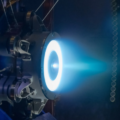Chinese scientists claim to be on the cusp of a significant breakthrough in underwater military technology, developing a new laser propulsion system that could lead to a new class of “superfast, silent” submarines.
According to recent reports by the South China Morning Post, Chinese scientists from Harbin Engineering University in Heilongjiang province are refining a system that might enable submarines to move faster than the speed of sound using laser-induced propulsion.
Researchers first introduced the new laser propulsion system at the “Applied Optics and Photonics” conference in Beijing in late 2023. During the proceedings, scientists explained that the system utilizes high-energy lasers to direct the force from cavitation implosions to propel a submarine.
In a paper recently published in the Chinese academic journal Acta Optica Sinica, scientists elaborated that the system, named “underwater fiber laser-induced plasma detonation wave propulsion,” works by directing laser energy through optical fibers. These fibers, as thin as human hairs, would coat the submarine’s exterior, allowing directed high-power laser beams to propel the vessel through the water.
The setup purportedly generates up to 70,000 newtons of thrust with just 2 megawatts of laser power, roughly equivalent to the force of a commercial jet engine.
The use of laser propulsion systems represents a significant departure from traditional propellants. Instead of relying on mechanical engines, this innovative method uses lasers to generate plasma in water, creating a wave that propels the vessel forward.
The concept of laser propulsion is associated with the phenomenon of supercavitation or the formation of bubbles around a submarine’s surface. This creates an air pocket that drastically reduces water resistance, allowing the submarine to achieve extraordinary speeds.
Theoretically, a submarine exploiting supercavitation could travel faster than the speed of sound, or nearly 667 knots-per-hour (767 mph). The Soviet twin-propeller K-222 submarine holds the fastest claimed underwater speed, reportedly clocking in at 44.7 knots during sea trials in 1969.
Laser propulsion operates similarly to a magnetohydrodynamic drive (MHD), a concept for marine propulsion that has been explored since the late 1960s.
While a magnetohydrodynamic drive propels a submarine by using electric and magnetic fields to accelerate a liquid or gas, a laser propulsion system propels the vessel using focused laser beams to create plasma.
Also similar to a magnetohydrodynamic drive (MHD), a laser propulsion system would have no moving parts, reducing a submarine’s autistic signature as it passes through the water.
The idea of using laser propulsion for submarines has been explored for decades. Yet, despite these efforts, previous attempts to develop the technology have failed to produce a system with enough power or thrust to be practical.
However, Chinese scientists, led by Dr. Ge Yang, an associate professor at Harbin Engineering University, have reportedly overcome previous hurdles in laser propulsion technology by innovating the structure used to harness and direct energy.
Traditionally, adding devices to constrain the propulsion mechanism was thought to cause significant energy loss. However, the team says they addressed this by integrating a device resembling a gun barrel at the ends of the optical fibers.
Further enhancements involved introducing specially designed structures within the barrels to minimize the interaction and internal friction between shock waves, thereby maximizing the propulsion force.
Researchers said insights from the Chinese aerospace defense sector, particularly in advanced plasma electric propulsion used in hypersonic weapons, were instrumental in refining the technology.
Despite this development’s potential, researchers have not yet addressed several critical challenges. These include confronting the problem of heat dissipation in the optical fibers, their durability in harsh underwater environments, and the integration of the system with existing submarine designs, particularly the surfacing and steering mechanisms.
These issues must be resolved before this novel laser propulsion system is considered viable. However, if realized, the military implications of such technology are significant.
Submarines are vital to national security because of their stealth capabilities and firepower. Successfully developing an operational laser propulsion system would significantly improve the stealth and speed of China’s naval forces, potentially altering the strategic dynamics in the ongoing technological rivalry between Beijing and the United States.
In their paper, researchers note that this breakthrough laser propulsion technology would not be limited to submarines. In addition to improving the efficiency of civilian ships to achieve “green shipping,” authors say the system could enhance a number of naval weapons.
“The system can effectively control the generation of laser energy and spot, achieving precise microsphere propulsion,” researchers wrote. “This method can also be applied to underwater weapons, causing a supercavitation phenomenon, thereby significantly increasing the underwater range of projectiles, underwater missiles, or torpedoes.”
Tim McMillan is a retired law enforcement executive, investigative reporter and co-founder of The Debrief. His writing typically focuses on defense, national security, the Intelligence Community and topics related to psychology. You can follow Tim on Twitter: @LtTimMcMillan. Tim can be reached by email: tim@thedebrief.org or through encrypted email: LtTimMcMillan@protonmail.com

